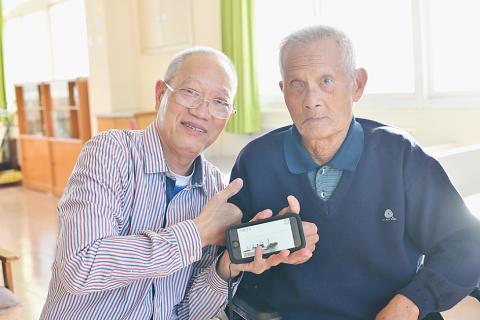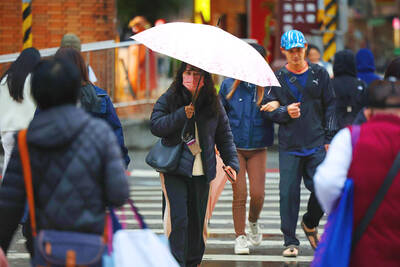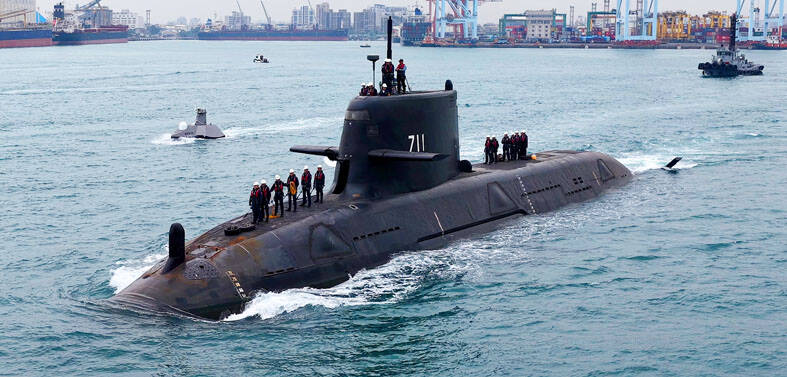Pingtung County nonagenarian Yang Tien-fu (楊天富), a Japanese merchant marine veteran, is one of the last living witnesses to the sinking of the Japanese landing craft transport ship Tamatsu Maru during World War II.
The Tamatsu Maru was torpedoed and sank with the loss of 5,000 lives off the coast of the Philippines near Luzon on Aug. 19, 1944.
Historian Nien Chih-cheng (念吉成) said Yang’s story will be included in his latest book about the Pacific War, which has the tentatively titled of Tears of Bashi Channel (巴士海峽之淚).

Photo: Tsai Tsung-hsien, Taipei Times
Yang, 91, recently talked about some of his wartime experiences with the Chinese-language Liberty Times (the Taipei Times’ sister newspaper).
After graduating from a public high school in Checheng Township (車城) at 16, Yang said he took the entrance exam for a merchant marine engineer’s course in Kobe, Japan, without telling his family.
Having passed the exam, he entered the program in April 1943, and after graduation, he was assigned to the cargo ship Osaka Maru, which ran supplies to a Japanese garrison on Saipan Island.
“That was how I got into the Pacific War,” he said.
The Osaka Maru was torpedoed by Allied submarines on May 25, 1944; Yang made it onto a lifeboat with an experienced sailor, Masayuki Tanaka, and six Japanese servicemen.
Although the lifeboat had ample potable water and rations, the six servicemen succumbed to psychological distress and depression, and only Yang and Tanaka survived.
After being rescued, Yang and Tanaka were transported to Samal Island, where he was drafted into a “temporary enlistment” to help with Japanese defenses, he said.
After the island was blockaded by an Allied fleet, most of the food ran out, and the Japanese troops subsisted mainly on stockpiled soybeans and they had to evade Filipino guerrillas, he said.
His knowledge of how to cook green mangoes, green bananas and cassava helped him and many of his comrades survive until they were able to be evacuated to Japan, he said.
He was then assigned as an engineer to the Kibitsu Maru, a merchant ship that had been converted into a military transport bristling with anti-aircraft batteries.
The Kibtitsu Maru left the port of Moji in Kyushu in August 1944 and joined the Tamatsu Maru and other ships in a convoy carrying units of the elite Kwantung Army to the Philippines, he said.
After the flotilla reached the Bashi Channel, Allied submarines torpedoed the Tamatsu Maru and sank it, he said.
“The surface of the sea was covered with the corpses of my comrades. I saw Japanese soldiers holding their rifles shouting ‘Long live the emperor’ as they drowned. Korean soldiers shouted ‘eomeoni,’ their word for ‘mother.’ It was a terrible sight that I cannot forget,” he said.
The Kibitsu Maru was evacuating 500 sick or injured women of “special status” from Manila when it came under incessant air attacks on Aug. 7, 1945, that forced it to flee the Bashi Channel to Siaoliouciou Island (小琉球) off Pingtung.
The attacks were so intense that he was ordered to replace a wounded machine-gun loader and a blast blew his helmet off, he said.
“I took a cooking pot made of copper from the kitchen and put it on my head as a helmet. It was a dangerous battle,” he said.
Years later he ran into Hidetsugu Nakajima, a survivor of the Tamasui Maru, in Pingtung’s Hengchun Township (恆春), he said.
“We shared a very sad history,” he said.

US climber Alex Honnold is to attempt to scale Taipei 101 without a rope and harness in a live Netflix special on Jan. 24, the streaming platform announced on Wednesday. Accounting for the time difference, the two-hour broadcast of Honnold’s climb, called Skyscraper Live, is to air on Jan. 23 in the US, Netflix said in a statement. Honnold, 40, was the first person ever to free solo climb the 900m El Capitan rock formation in Yosemite National Park — a feat that was recorded and later made into the 2018 documentary film Free Solo. Netflix previewed Skyscraper Live in October, after videos

NUMBERS IMBALANCE: More than 4 million Taiwanese have visited China this year, while only about half a million Chinese have visited here Beijing has yet to respond to Taiwan’s requests for negotiation over matters related to the recovery of cross-strait tourism, the Tourism Administration said yesterday. Taiwan’s tourism authority issued the statement after Chinese-language daily the China Times reported yesterday that the government’s policy of banning group tours to China does not stop Taiwanese from visiting the country. As of October, more than 4.2 million had traveled to China this year, exceeding last year. Beijing estimated the number of Taiwanese tourists in China could reach 4.5 million this year. By contrast, only 500,000 Chinese tourists are expected in Taiwan, the report said. The report

Temperatures are forecast to drop steadily as a continental cold air mass moves across Taiwan, with some areas also likely to see heavy rainfall, the Central Weather Administration (CWA) said. From today through early tomorrow, a cold air mass would keep temperatures low across central and northern Taiwan, and the eastern half of Taiwan proper, with isolated brief showers forecast along Keelung’s north coast, Taipei and New Taipei City’s mountainous areas and eastern Taiwan, it said. Lows of 11°C to 15°C are forecast in central and northern Taiwan, Yilan County, and the outlying Kinmen and Lienchiang (Matsu) counties, and 14°C to 17°C

STEERING FAILURE: The first boat of its class is experiencing teething issues as it readies for acceptance by the navy, according to a recent story about rudder failure The Hai Kun (海鯤), the nation’s first locally built submarine, allegedly suffered a total failure of stern hydraulic systems during the second round of sea acceptance trials on June 26, and sailors were forced to manually operate the X-rudder to turn the submarine and return to port, news Web site Mirror Daily reported yesterday. The report said that tugboats following the Hai Kun assisted the submarine in avoiding collisions with other ships due to the X-rudder malfunctioning. At the time of the report, the submarine had completed its trials and was scheduled to begin diving and surfacing tests in shallow areas. The X-rudder,